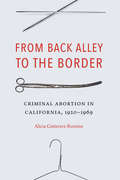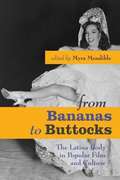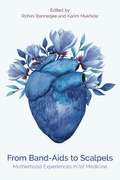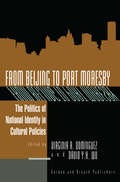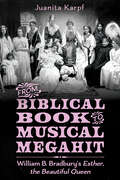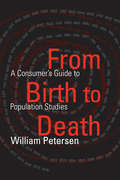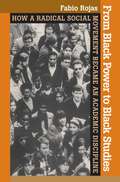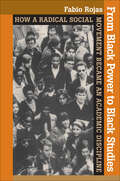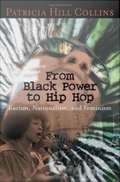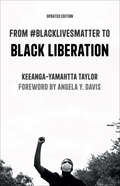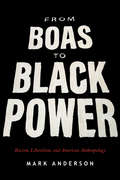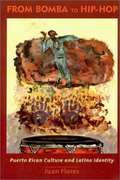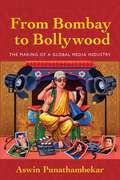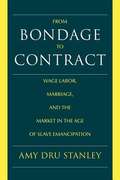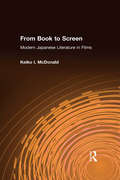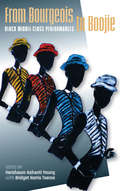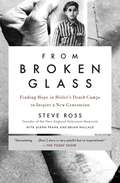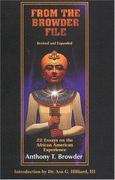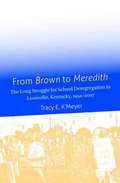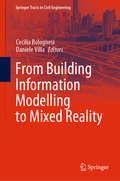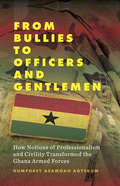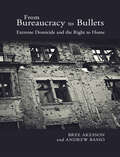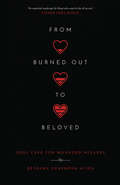- Table View
- List View
From Back Alley to the Border: Criminal Abortion in California, 1920-1969
by Alicia Gutierrez-RomineIn From Back Alley to the Border, Alicia Gutierrez-Romine examines the history of criminal abortion in California and the role abortion providers played in exposing and exploiting the faults in California&’s anti-abortion statute throughout the twentieth century. Focused on the women who used this underground network and the physicians who facilitated it, Gutierrez-Romine describes the operation of abortion providers from the 1920s through the 1960s, including regular physicians as well as women and African American abortionists, and the investigations and trials that surrounded them. During the 1930s the Pacific Coast Abortion Ring, a large, coast-wide, and comparatively safe organized abortion syndicate, became the target of law enforcement agencies, forcing abortions across the border into Mexico and ushering in an era of Tijuana &“abortion tourism&” in the early 1950s. The movement south of the border ultimately compelled the California Supreme Court to rule its abortion statute &“void for vagueness&” in People v. Belous in 1969—four years before Roe v. Wade. Gutierrez-Romine presents the first book focused on abortion on the West Coast and the border between the United States and Mexico and provides a new approach to studying how providers of illegal abortions and their female clients navigated this underground network.
From Bananas to Buttocks
by Myra MendibleFrom the exuberant excesses of Carmen Miranda in the "tutti frutti hat" to the curvaceous posterior of Jennifer Lopez, the Latina body has long been a signifier of Latina/o identity in U. S. popular culture. But how does this stereotype of the exotic, erotic Latina "bombshell" relate, if at all, to real Latina women who represent a wide spectrum of ethnicities, national origins, cultures, and physical appearances? How are ideas about "Latinidad" imagined, challenged, and inscribed on Latina bodies? What racial, class, and other markers of identity do representations of the Latina body signal or reject? In this broadly interdisciplinary book, experts from the fields of Latina/o studies, media studies, communication, comparative literature, women's studies, and sociology come together to offer the first wide-ranging look at the construction and representation of Latina identity in U. S. popular culture. The authors consider such popular figures as actresses Lupe Vélez, Salma Hayek, and Jennifer Lopez; singers Shakira and Celia Cruz; and even the Hispanic Barbie doll in her many guises. They investigate the media discourses surrounding controversial Latinas such as Lorena Bobbitt and Marisleysis González. And they discuss Latina representations in Lupe Solano's series of mystery books and in the popular TV shows El Show de Cristina and Laura en América. This extensive treatment of Latina representation in popular culture not only sheds new light on how meaning is produced through images of the Latina body, but also on how these representations of Latinas are received, revised, and challenged.
From Band-Aids to Scalpels: Motherhood Experiences in/of Medicine
by Rohini Bannerjee;Karim MukhidaThis interdisciplinary anthology contributes to the contemporary dialogues about motherhood/mothering drawing attention to the experiences of motherhood/mothering both within medical practice as physicians as well as highlighting motherhood/mothering experiences of medicine, examining both mothers as patients themselves and with their children as patients. As medical schools steadily increase the number of women studying medicine, research on mothers in medical practice would add to a better understanding on the different values, expectations, institutions, and events that shape and define the identities within medicine. How does the increase of women as mothers practicing medicine affect the outcomes of mothers as patients? Does birthing your own child impact your practice? Does knowing your physician or your child's physician is a mother affect your experience as a patient or that of your child's? The edited volume will explore how relationships between motherhood/mothering experiences in/of medicine are presently being theorized, re-examined, negotiated, and most importantly, debated. This is an interdisciplinary volume which unites essays as well as creative submissions that engage with the issue of motherhood experiences in/of medicine, including works of fiction and creative non-fiction in addition to traditional academic writing, allowing an open and innovative space for critical discussion.
From Beijing to Port Moresby: The Politics of National Identity in Cultural Policies
by David Y. H. Wu Virginia R. DomínguezEssays in this volume focus on Singapore, Papua New Guinea, Taiwan, Japan, Thailand, and the People's Republic of China as sites rife with discursive complexity. From small to large, young to old, former colony to former colonial power, these six examples do well to represent situated voices and cultural values meted out in a larger "global" space.
From Biblical Book to Musical Megahit: William B. Bradbury's Esther, the Beautiful Queen
by Juanita KarpfMany churchgoers will recognize the name William Bradbury, a nineteenth-century American composer of popular hymns still sung at Sunday services. Bradbury’s name may also bring to mind Esther, the Beautiful Queen, his choral setting of a text based on the biblical Book of Esther. The uncomplicated score became enormously popular almost immediately after its initial publication in 1856. In From Biblical Book to Musical Megahit: William B. Bradbury’s “Esther, the Beautiful Queen,” Juanita Karpf traces the work’s rich performance and reception history. Bradbury emphatically stated that he intended Esther to be sung as an unadorned religious and educational piece. Yet many music directors exploited the potential for his score, producing elaborately staged events with costumes, scenery, and acting. Although directors retained Bradbury’s original music, they nonetheless facilitated Esther’s rapid entrée into the realm of music theater. This stylistic transformation ignited a firestorm of controversy. Some clergy and religiously pious citizens condemned theatrical representations of biblical texts as the epitome of debauchery, sacrilege, and sin. In contrast, more tolerant and open-minded theater enthusiasts welcomed the dramatic staging of Esther as wholesome entertainment and as evidence of a refreshingly enlightened approach to biblical interpretation. However heated this debate seemed at times, it did little to quell the continued rise in popularity of Esther. In fact, by the late 1860s, Bradbury’s score had worked its way across the continent, north to Canada and, eventually, to Great Britain, Australia, Asia, and Africa. With performances recorded over a century after Bradbury published his score, Esther became, by any measure, an international megahit.
From Birth to Death: A Consumer's Guide to Population Studies
by William PetersenFrom Birth to Death is a detailed analysis of how population statistics are collected in the United States, particularly by the Bureau of the Census. It describes the errors and other flaws typically found in such data.Petersen sets out the fundamentals of demography and reviews the current proposal to use sampling in the census. He then reviews examples of how ignoring age and sex structure leads to false conclusions. Petersen explores race and ethnicity and the dilemmas inherent in the necessarily ambiguous definitions of these categories. He also analyzes the problems of women who postpone having children to ages when risks of failure become significant.The author also reviews the two most prominent population theories Malthus and the fertility transition and questions why predictions of future population size are often completely wrong. The final chapter discusses the pros and cons of state intervention in the control of fertility and efforts to cut family size in less developed countries and their unclear results. A principal topic is the relative accuracy of population statistics and the degree to which one should accept data as published. The main focus is on the United States and especially on the Bureau of the Census, but general points are sometimes illustrated with examples of how data from other countries should be evaluated.
From Black Power to Black Studies: How a Radical Social Movement Became an Academic Discipline
by Fabio RojasWhile it is true much of the time that institutions of higher education reproduce the status quo in the manner described Pierre Bourdieu, this work by Rojas (sociology, Indiana U.) demonstrates that they are also places of political contestation. He describes the institutionalization of Black studies within American colleges and universities, arguing that the process can best be viewed as a bureaucratic response to a social movement. He goes beyond a focus on mobilization in order to address issues of legitimization in organizational change.
From Black Power to Black Studies: How a Radical Social Movement Became an Academic Discipline
by Fabio RojasThe black power movement helped redefine African Americans' identity and establish a new racial consciousness in the 1960s. As an influential political force, this movement in turn spawned the academic discipline known as Black Studies. Today there are more than a hundred Black Studies degree programs in the United States, many of them located in America’s elite research institutions. In From Black Power to Black Studies, Fabio Rojas explores how this radical social movement evolved into a recognized academic discipline.Rojas traces the evolution of Black Studies over more than three decades, beginning with its origins in black nationalist politics. His account includes the 1968 Third World Strike at San Francisco State College, the Ford Foundation’s attempts to shape the field, and a description of Black Studies programs at various American universities. His statistical analyses of protest data illuminate how violent and nonviolent protests influenced the establishment of Black Studies programs. Integrating personal interviews and newly discovered archival material, Rojas documents how social activism can bring about organizational change.Shedding light on the black power movement, Black Studies programs, and American higher education, this historical analysis reveals how radical politics are assimilated into the university system.
From Black Power to Hip Hop: Racism, Nationalism, and Feminism
by Patricia Hill CollinsDespite legislation designed to eliminate unfair racial practices, the United States continues to struggle with a race problem. Some thinkers label this a "new" racism and call for new political responses to it. Using the experiences of African American women and men as a touchstone for analysis, Patricia Hill Collins examines new forms of racism as well as political responses to it. In this incisive and stimulating book, renowned social theorist Patricia Hill Collins investigates how nationalism has operated and re-emerged in the wake of contemporary globalization and offers an interpretation of how black nationalism works today in the wake of changing black youth identity. Hers is the first study to analyze the interplay of racism, nationalism, and feminism in the context of twenty-first century black America. From Black Power to Hip Hop covers a wide range of topics including the significance of race and ethnicity to the American national identity; how ideas about motherhood affect population policies; African American use of black nationalism ideologies as anti-racist practice; and the relationship between black nationalism, feminism and women in the hip-hop generation.
From Black Power to Prison Power
by Donald F. TibbsThis book uses the landmark case Jones v. North Carolina Prisoners' Labor Union to examine the strategies of prison inmates using race and radicalism to inspire the formation of an inmate labor union.
From #BlackLivesMatter to Black Liberation
by Keeanga-Yamahtta TaylorThe author of Race for Profit carries out &“[a] searching examination of the social, political and economic dimensions of the prevailing racial order&” (Michelle Alexander, author of The New Jim Crow). In this winner of the Lannan Cultural Freedom Prize for an Especially Notable Book, Keeanga-Yamahtta Taylor &“not only exposes the canard of color-blindness but reveals how structural racism and class oppression are joined at the hip&” (Robin D. G. Kelley, author of Freedom Dreams). The eruption of mass protests in the wake of the police murders of Michael Brown in Ferguson, Missouri, and Eric Garner in New York City have challenged the impunity with which officers of the law carry out violence against black people and punctured the illusion of a post-racial America. The Black Lives Matter movement has awakened a new generation of activists. In this stirring and insightful analysis, activist and scholar Keeanga-Yamahtta Taylor surveys the historical and contemporary ravages of racism and the persistence of structural inequality, such as mass incarceration and black unemployment. In this context, she argues that this new struggle against police violence holds the potential to reignite a broader push for black liberation. &“This brilliant book is the best analysis we have of the #BlackLivesMatter moment of the long struggle for freedom in America. Keeanga-Yamahtta Taylor has emerged as the most sophisticated and courageous radical intellectual of her generation.&” —Dr. Cornel West, author of Race Matters &“A must read for everyone who is serious about the ongoing praxis of freedom.&” —Barbara Ransby, author of Ella Baker and the Black Freedom Movement &“[A] penetrating, vital analysis of race and class at this critical moment in America&’s racial history.&” —Gary Younge, author of The Speech: The Story Behind Dr. Martin Luther King Jr.'s Dream
From Boas to Black Power: Racism, Liberalism, and American Anthropology
by Mark AndersonFrom Boas to Black Power investigates how U.S. cultural anthropologists wrote about race, racism, and "America" in the 20th century as a window into the greater project of U.S. anti-racist liberalism. Anthropology as a discipline and the American project share a common origin: their very foundations are built upon white supremacy, and both are still reckoning with their racist legacies. In this groundbreaking intellectual history of anti-racism within twentieth-century cultural anthropology, Mark Anderson starts with the legacy of Franz Boas and Ruth Benedict and continues through the post-war and Black Power movement to the birth of the Black Studies discipline, exploring the problem "America" represents for liberal anti-racism. Anderson shows how cultural anthropology contributed to liberal American discourses on race that simultaneously bolstered and denied white domination. From Boas to Black Power provides a major rethinking of anthropological anti-racism as a project that, in step with the American racial liberalism it helped create, paradoxically maintained white American hegemony. Anthropologists influenced by radical political movements of the 1960s offered the first sustained challenge to that project, calling attention to the racial contradictions of American liberalism reflected in anthropology. Their critiques remain relevant for the discipline and the nation.
From Bomba to Hip-Hop: Puerto Rican Culture and Latino Identity (Popular Cultures, Everyday Lives)
by Juan FloresJuan Flores considers the uniqueness of Puerto Rican culture and identity in relation to that of other Latino groups in the United States--as well as to other minority groups, especially African Americans. Architecture and urban space, literary traditions, musical styles, and cultural movements provide some of the sites and moments of a cultural world defined by the interplay of continuity and transformation, heritage and innovation, roots and fusion. Exploring this wide range of cultural expression--both in the diaspora and in Puerto Rico--Flores highlights the rich complexities and fertile contradictions of Latino identity.
From Bombay to Bollywood: The Making of a Global Media Industry (Postmillennial Pop #5)
by Aswin PunathambekarFrom Bombay to Bollywood analyzes the transformation of the national film industry in Bombay into a transnational and multi-media cultural enterprise, which has come to be known as Bollywood. Combining ethnographic, institutional, and textual analyses, Aswin Punathambekar explores how relations between state institutions, the Indian diaspora, circuits of capital, and new media technologies and industries have reconfigured the Bombay-based industry’s geographic reach. Providing in-depth accounts of the workings of media companies and media professionals, Punathambekar has produced a timely analysis of how a media industry in the postcolonial world has come to claim the global as its scale of operations. Based on extensive field research in India and the U.S., this book offers empirically-rich and theoretically-informed analyses of how the imaginations and practices of industry professionals give shape to the media worlds we inhabit and engage with. Moving beyond a focus on a single medium, Punathambekar develops a comparative and integrated approach that examines four different but interrelated media industries--film, television, marketing, and digital media. Offering a path-breaking account of media convergence in a non-Western context, Punathambekar’s transnational approach to understanding the formation of Bollywood is an innovative intervention into current debates on media industries, production cultures, and cultural globalization.
From Bondage To Contract: Wage Labor, Marriage, And The Market In The Age Of Slave Emancipation
by Amy Dru StanleyThis book explores how a generation of American thinkers and reformers - abolitionists, former slaves, feminists, labor advocates, jurists, moralists, and social scientists - drew on contract to condemn the evils of chattel slavery as well as to measure the virtues of free society. Their arguments over the meaning of slavery and freedom were grounded in changing circumstances of labor and home life on both sides of the Mason-Dixon line. At the heart of these arguments lay the problem of defining which realms of self and social existence could be rendered market commodities and which could not. From Bondage to Contract reveals how the problem of distinguishing between what was saleable and what was not reflected the ideological and social changes wrought by the concurrence of abolition in the South and burgeoning industrial capitalism in the North.
From Book to Screen: Modern Japanese Literature in Films
by Keiko I. McDonaldOf all the world s cinemas, Japan's is perhaps unique in its closeness to the nation's literature, past and contemporary. The Western world became aware of this when Akira Kurosawa's Rashomon was awarded the Grand Prize at the Venice film festival in 1951 and the Oscar for best foreign film in 1952. More recent examples include Shohei Imamura's Eel, which won the Palm d'Or (Best Picture) at Cannes in 1997.From Book to Screen breaks new ground by exploring important connections between Japan's modern literary tradition and its national cinema. The first part offers an historical and cultural overview of the working relationship that developed between pure literature and film. It deals with three important periods in which filmmakers relied most heavily on literary works for enriching and developing cinematic art. The second part provides detailed analyses of a dozen literary works and their screen adoptions.
From Bourgeois to Boojie: Black Middle-Class Performances
by Vershawn Ashanti Young Bridget Harris TsemoExamines how generations of African Americans perceive, proclaim, and name the combined performance of race and class across genres.
From Boycott to Economic Cooperation: The Political Economy of the Arab Boycott of Israel
by Gil FeilerA study of the Arab economic boycott of Israel. This title includes the evolution and development of the boycott, and examines aspects such as theory, practice and legality of the longest-lasting example of economic sanctions in the 20th century.
From Broken Glass: My Story of Finding Hope in Hitler's Death Camps to Inspire a New Generation
by Ray Flynn Steve Ross Glenn Frank Brian WallaceFrom the survivor of ten Nazi concentration camps who went on to create the New England Holocaust Memorial, an inspiring memoir about finding strength in the face of despair.On August 14, 2017, two days after a white-supremacist activist rammed his car into a group of anti-Fascist protestors, killing one and injuring nineteen, the New England Holocaust Memorial was vandalized for the second time in as many months. At the base of one of its fifty-four-foot glass towers lay a pile of shards. For Steve Ross, the image called to mind Kristallnacht, the Night of Broken Glass in which German authorities and civilians ransacked Jewish-owned buildings with sledgehammers.Ross was eight years old when the Nazis invaded his Polish village, forcing his family to flee. He spent his next six years in a day-to-day struggle to survive the notorious camps in which he was imprisoned, Auschwitz-Birkenau and Dachau among them. When he was finally liberated, he no longer knew how old he was, he was literally starving to death, and everyone in his family save for his brother had been killed.Ross learned in his darkest experiences--by observing and enduring inconceivable cruelty as well as by receiving compassion from caring fellow prisoners--the human capacity to rise above even the bleakest circumstances. He decided to devote himself to underprivileged youth, aiming to ensure that despite the obstacles in their lives they would never experience suffering like he had. Over the course of a nearly forty-year career as a psychologist working in the Boston city schools, that was exactly what he did. At the end of his career, he spearheaded the creation of the New England Holocaust Memorial, a site millions of people including young students visit every year.Equal parts heartrending, brutal, and inspiring, From Broken Glass is the story of how one man survived the unimaginable and helped lead a new generation to forge a more compassionate world.
From The Browder File: 22 Essays On The African American Experience (From The Browder File)
by Anthony Browder Zelma Peterson Malcolm Aaron Asa HilliardFrom the Browder File: 22 Essays on the African American Experience
From Brown to Meredith
by Tracy E. K'MeyerWhen the Supreme Court overturned Louisville's local desegregation plan in 2007, the people of Jefferson County, Kentucky, faced the question of whether and how to maintain racial diversity in their schools. This debate came at a time when scholars, pundits, and much of the public had declared school integration a failed experiment rightfully abandoned. Using oral history narratives, newspaper accounts, and other documents, Tracy E. K'Meyer exposes the disappointments of desegregation, draws attention to those who struggled for over five decades to bring about equality and diversity, and highlights the many benefits of school integration. K'Meyer chronicles the local response to Brown v. Board of Education in 1956 and describes the start of countywide busing in 1975 as well as the crisis sparked by violent opposition to it. She reveals the forgotten story of the defense of integration and busing reforms in the 1980s and 1990s, culminating in the response to the 2007 Supreme Court decision known as Meredith. This long and multifaceted struggle for school desegregation, K'Meyer shows, informs the ongoing movement for social justice in Louisville and beyond.
From Building Information Modelling to Mixed Reality (Springer Tracts in Civil Engineering)
by Cecilia Bolognesi Daniele VillaThis book reports on the latest advances in using BIM modelling to achieve the semantic enrichment of objects, allowing them to be used both as multidimensional databases – as comprehensive sources of information for finalizing various types of documentation in the building industry – and as modelling tools for the construction of virtual environments. Having advanced to a new stage of development, BIM modelling is now being applied in a range of increasingly complex contexts, and for various new purposes. This book examines the role that virtual reality and related technologies such as AI and IoT can play in preserving and disseminating our cultural heritage and built environment.
From Bullies to Officers and Gentlemen: How Notions of Professionalism and Civility Transformed the Ghana Armed Forces
by Humphrey Asamoah AgyekumBased on unprecedented access to the Ghanaian military barracks and inspired by the recent resurgence of coups in West Africa, Agyekum assesses why and how the Ghana Armed Forces were transformed from an organization that actively orchestrated coups into an institution that accepts the authority of the democratically elected civilian government. Focusing on the process of professionalization of the Ghanaian military, this ethnography based monograph examines both historical and contemporary themes, and assesses the shift in military personnel from ‘Buga Buga’ soldiers – uneducated, lower-class soldiers, human rights abusers – to a more ‘modern’ fighting force.
From Bureaucracy to Bullets: Extreme Domicide and the Right to Home (Genocide, Political Violence, Human Rights)
by Bree Akesson Andrew R. BassoThere are currently a record-setting number of forcibly displaced persons in the world. This number continues to rise as solutions to alleviate humanitarian catastrophes of large-scale violence and displacement continue to fail. The likelihood of the displaced returning to their homes is becoming increasingly unlikely. In many cases, their homes have been destroyed as the result of violence. Why are the homes of certain populations targeted for destruction? What are the impacts of loss of home upon children, adults, families, communities, and societies? If having a home is a fundamental human right, then why is the destruction of home not viewed as a rights violation and punished accordingly? From Bureaucracy to Bullets answers these questions and more by focusing on the violent practice of extreme domicide, or the intentional destruction of the home, as a central and overlooked human rights issue.
From Burned Out to Beloved: Soul Care for Wounded Healers
by Bethany Dearborn HiserAs a social worker, jail chaplain, and justice advocate, Bethany Dearborn Hiser pushed herself to the brink of burnout—and then kept going. Stress, despair, and compassion fatigue overwhelmed her ability to function. She was called to serve the abused, addicted, and homeless people in her community. Yet she was emotionally and spiritually exhausted. Something needed to change. Searching for answers, Hiser learned that trauma affects everyone who is exposed to it—not only those experiencing it firsthand. Psychologists call it "secondary trauma." She realized that she needed the very soul care that she was providing to others. From Burned Out to Beloved is Hiser's story of burnout, self-discovery, and spiritual renewal. But more than that, it's a trauma-informed soul care guide for all Christians working in high-stress, helping professions. Whether you're a social worker, therapist, pastor, teacher, or healthcare professional, From Burned Out to Beloved will equip you to confess your limitations, embrace your identity as a beloved child of God, and flourish in your vocation.
